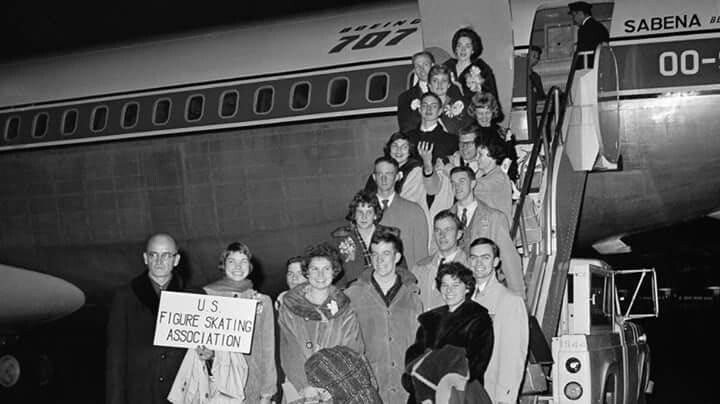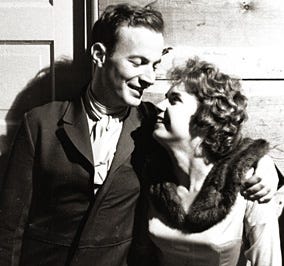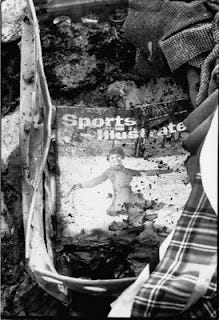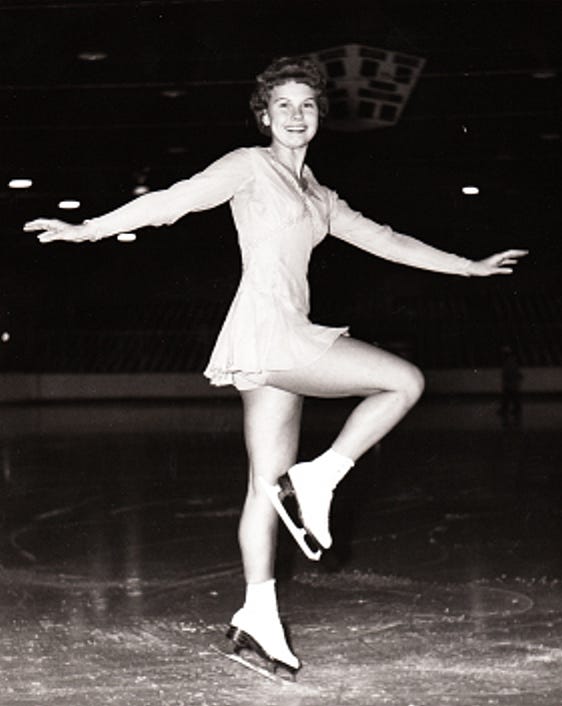Out of the Ashes: The Loss of the 1961 US World Figure Skating Team
The History We Hoped Never to See Repeated
Young figure skaters, with their whole lives and careers ahead of them, gone in a terrible plane crash. America’s future champions, remembered only in photographs and on video, taken too soon. Names etched on tombstones and memorials instead of trophies. Kids with Olympic dreams and big talent, famous for something unforeseen — for tragedy in the air instead of victory on the ice.
A story that could be ripped from last month’s tragic headlines — but, sadly, this is not the first time US Figure Skating has faced such devastation.
On Valentine’s Day in 1961, the eighteen figure skaters who made up the entire US World Team posed for one last photograph before boarding a Boeing 707 for their flight from Idlewild (now JFK) airport in New York, bound for Brussels and then the World Championships in Prague. They were accompanied by six coaches, two judges, a referee, the team manager, and six family members of various skaters and officials. All told, nearly half the jet’s passengers were associated with the US Figure Skating Association.
With many of the top skaters from the 1960 Olympics in Squaw Valley having retired from competition, the future was a blank slate in 1961, and the US had high hopes that American skaters would dazzle in Prague. If things went well, they could start a course toward what would be a third Olympic gold medal in a row for American ladies skaters in 1964. (Tenley Albright won in 1956 and Carol Heiss in 1960.) And US men were on track for something even more impressive, having won every Olympic gold since 1948. (Dick Button won in 1948 and 1952, Hayes Allen Jenkins won in 1956, and his brother David won in 1960.)
But the team would never make it to Prague to take the world by storm.
As the 707 approached the runway at the Brussels airport, onlookers witnessed a desperate attempt to land the plane despite an apparent mechanical failure. After a third circle around the airfield, the plane was seen to climb back to 1,500 feet before leveling off, losing speed, and spiraling to the earth, nose pointed straight down.
Sabena Flight 548 landed in a Belgian field at five minutes past ten in the morning on 15 February 1961, less than two miles from its intended destination with seventy-two souls on board.
A Catholic priest who was passing by attempted to approach the wreck site to save any potential survivors and give a final blessing to the dying, but the heat of the already raging fire was too much and he was forced to retreat.
Airport rescue vehicles sped to the crashed aircraft and arrived just moments after impact, but they found the 707 already engulfed in flames.
There were no survivors.
On the ground, an additional victim (a farmer who was working in a nearby field) was killed and another farm worker would lose his leg after being struck by flying debris.
Baudouin I, King of the Belgians, and Queen Fabiola visited the wreck site and personally donated oak coffins with the royal seal, which were used to bring the victims home.
President John F. Kennedy, who knew US pairs champion Dudley Richards (who had been a Harvard University roommate of the president’s brother, Ted, and spent summers at Hyannis Port with the Kennedy family), said in a statement: "Our country has sustained a great loss of talent and grace which had brought pleasure to people all over the world. Mrs. Kennedy and I extend our deepest sympathy to the families and friends of all the passengers and crew who died in this crash."
Investigators puzzled the mystery of the crash for years, eventually determining that the jet’s stabilizers were most likely to blame. But no definitive answer for the most devastating disaster in figure skating history has ever been firmly given.
Back in the United States, the loss of America’s top young skaters was headline news. And the ripples of this loss would be felt for decades to come.
In a recent interview in the wake of January’s midair collision in Washington DC, Doug Zeghibe, the CEO of The Skating Club of Boston, stated that the 1961 crash “had long-reaching implications for the skating club and for the sport in this country, because when you lose coaches like this, you lose the future of the sport as well. It’s been a long time in redeveloping it, and I personally feel that this club, the Skating Club of Boston, has just now, almost 60 years later, been coming out of the shadow of that 1961 crash, so this is particularly devastating.”
Figure skating is a sport that is dynastic, in a way. Knowledge of skills and artistry are passed down from coach to student and so on, for decades and beyond. Today, as in 1961, that chain has been broken and skating clubs are being forced to rebuild without the wisdom and presence of the very people who drive the sport forward.
A few of the skaters lost aboard Sabena Flight 458 were part of an American figure skating dynasty in a more literal sense. Legendary skater, coach, and author Maribel Vinson Owen (herself an Olympic and World Championship medalist and the holder of more US Figure Skating Championship titles (9 ladies titles and 4 in pairs) than any other skater in history, even today) was accompanying her daughters, who were also her students. They were based at the Skating Club of Boston, which was devastated by her loss.
Maribel’s students have made a tremendous impact on the sport and her legacy continues to this day. 1956 Olympic Champion Tenley Albright — the first American to win Olympic gold in ladies figure skating — had been taught by Maribel Vinson. One of Maribel’s many students was Mabel Fairbanks, a trailblazing show skater and coach who broke figure skating’s color barrier and went on to teach such champions as Tai Babilonia and Randy Gardner.
Frank Carroll, the legendary coach who taught Michelle Kwan, Evan Lysacek, Denis Ten, Linda Fratianne, Carolina Kostner and so many others was, himself, a student of Maribel’s who had just turned professional and joined the Ice Follies at the time of the crash. Decades later, when he was preparing Linda Fratianne to skate at the 1980 Olympics where she would bring home a silver medal, he spoke of wishing to call Maribel for advice.
Maribel’s older daughter, Maribel Y Owen, was the US Champion in pairs skating with her partner, Dudley Richards. They’d placed 10th at the 1960 Olympics and were ready to climb to greater heights. And, in their personal life, they were a couple who may have married and perhaps would have continued on the Vinson-Owen legacy into a third generation.
Maribel’s younger daughter, Laurence “Laurie” Owen, was, at just sixteen, US Champion in the ladies division — and on the cover of the latest edition of Sports Illustrated after her wins at Nationals and the North American Championships. The press had all but crowned the bubbly young skater with a pixie cut and a million-dollar smile a future Olympic champion.
But Laurie had competition — and that competition came in the form of Stephanie “Steffi” Westerfeld, a homecoming queen who trained in Colorado Springs at the legendary Broadmoor club. At the 1961 Nationals held at the Broadmoor, Steffi had been in the lead after the compulsory figures portion and very nearly won the free skate, as well. An accomplished pianist and ballroom dancer as well as a figure skater, Steffi chose to compete at the World Figure Skating Championships in lieu of attending a piano competition in Philidelphia that same week. Her sister Sherri, also a figure skater but not a member of the team, accompanied Steffi on the fatal flight.
The Owens and the Westerfelds weren’t the only siblings headed to Prague for Worlds. Ila Ray and Ray Hadley (the US Silver medalists) and Laurie and Bill Hickox (the US Bronze medalists) were both brother/sister pairs, making for devastating losses for both families. The Hadleys, who had almost been unable to go to Worlds due to financial constraints, had found last minute funding for the trip and were accompanied by their mother, who was also their coach. The Hickoxs had originally decided not to compete in 1961 because Bill had joined the military, but their mother had convinced them to try one more time and he was given leave from the Air Force Academy to compete.
Nearly missing the opportunity to compete at the 1961 Worlds was a recurring theme among the US team.
Doug Ramsey, the 1961 US pewter (4th place) medalist, originally didn’t make the World Team. At Nationals, the talented young skater was the only one in the competition with a triple jump, giving him the nickname “Dick Button, Jr.” But his poor performance in compulsory figures kept him from a higher rung on the podium and a spot for Worlds. Of course, that sadly wasn’t the end of the story. When the bronze medalist withdrew due to illness, Doug found himself with a ticket to Prague. Sadly, this tremendous young talent whose free skating had been compared to the legendary Dick Button never had a chance to develop to his full potential.
In 1961, Ice Dance was still a discipline in its infancy, having only been added to the World Championships in 1952. It wouldn’t be added to the Olympics until 1976. But that didn’t stop the US from sending three talented teams to Worlds.
Diane Sherbloom and Larry Pierce were another unlikely addition to the 1961 World Team. In fact, Diane hadn’t even been planning to enter the 1961 US Nationals at all after retiring from skating with her high school graduation in 1960. But, in December 1960, Larry’s partner, with whom he’d previously medaled at Nationals and competed at Worlds, broke her ankle. Desperate, Larry convinced Diane to skate with him. With just weeks to prepare their programs and form a partnership, Diane and Larry did the impossible and became National Champions in January 1961.
Patricia and Robert Dineen, the US bronze medalists in Ice Dance, were a young married couple. They welcomed their first child, a boy, in the summer of 1960, but that didn’t stop the new parents from chasing their dreams on the ice. Their son, Robert Jr, was raised by Robert, Sr’s brother in the wake of the crash.
The Dineens weren’t the only crash victims who left behind young children. Coach Eduard "Edi" Scholdan, who was accompanying several of his students to Worlds, left behind a young son and stepdaughter. His thirteen-year-old son was on the flight with him.
And coach Billy Kipp of Pasadena, California left behind another legacy — like all the coaches aboard Sabena Flight 485, he left behind the students he had once taught. In Billy’s case, one of those young skaters was a 12-year-old named Peggy Fleming who would later go on to train with Italian coach Carlo Fassi.
The US Figure Skating Association was reeling after the loss of so many top skaters and coaches. 1960 Olympic bronze medalist Barbara Rolls, who was still eligible to compete because, as a very new mother, she hadn’t turned professional after the Olympics, returned to competition.
Rinks began to look overseas for more instructors who could fill in the void left by those who had been lost. Carlo Fassi and his wife, Christa, came to the United States to teach at the Broadmoor after the loss of the 1961 team. And he wasn’t alone in that. John Nicks, a World Champion in pairs from England, received four offers to coach in the United States after the crash.
The Memorial Fund was established within days of the crash to honor the lives lost and to fund the training of the next generation of skaters. One of the first successes of the fund was the development of Peggy Fleming, who would go on to take home Olympic gold in 1968.
The legacy of those who were lost in that Belgian field has never been forgotten. In 2011, to mark the 50th anniversary of the crash, a documentary called RISE was produced as a fundraiser for the Memorial Fund and to memorialize the 1961 World Team, all of whom have been inducted into the US Figure Skating Hall of Fame.
Today, on the anniversary of the 1961 crash and in the wake of another terrible air travel tragedy that took the lives of young skaters who were returning home from the National Development Camp, we remember not only those we’ve just lost, but also those who were taken too soon more than sixty years ago.
May their memory be eternal.
And may all skaters remember that we have risen from the ashes before, and we will do so again.
Dive Deeper:
Montreal Gazette, Feb 16, 1961
Pittsburg Post-Gazette: Feb 16, 1961
1961 World Team page on Cemetery Guide
Interview with Skating Club of Boston CEO, January 2025
Profiles and Pictures of All the Skaters and Coaches
For those interested in seeing these skaters and their performances at the 1961 US Figure Skating Championships, here are videos of their free skate or free dance:
Ladies Silver: Stephanie Westerfeld
Ladies Bronze: Rhode Lee Michelson
Pairs Gold: Maribel Owen & Dudley Richards
Pairs Silver: Ila Ray Hadley & Ray Hadley, Jr.
Pairs Bronze: Laurie Hickox & William Hickox (Snippet only)
Ice Dance Gold: Diane Sherbloom & Larry Pierce











Super tragic